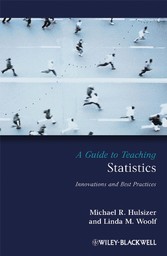Search and Find
Service
Series Editors’ Preface
13
Preface
17
I Course Preparation
21
Chapter 1 Teaching Statistics A beginning
23
So Why Teach Statistics?
25
Historical Pedagogical Controversies
27
Who should teach statistics?
27
Statistics labs and related technology
28
Content of statistics courses
30
Statistics in Relation to the Discipline
31
Sequence of the Class and Topics
32
Introducing Research Methods within the Context of Statistics
36
Student Populations
37
Mathematical ability
37
Cognitive ability and learning styles
39
Self-efficacy and motivation
40
Gender
42
Helping Your Students Survive Statistics
43
Conclusion
45
Chapter 2 Nuts and Bolts of Teaching Statistics
47
Syllabus Construction
48
Textbook Selection
50
Conceptual orientation
51
Level of difficulty
53
Chapter topics and organization
54
Core formulas and vocabulary
55
Type of data sets/quality of the exercises
56
Traditional Versus Electronic Textbooks
57
Supplemental Materials
58
Study guides
59
Companion Web sites
59
Computer tutorials
60
Electronic Discussion Boards
62
Multimedia Tools
64
Presentation technology
65
Interactive applications: Java applets, Flash, Shockwave, and HTML
66
Multimedia simulation programs
68
Conclusion
69
II Theoretical and Pedagogical Concerns
71
Chapter 3 Educational Reform in Statistics
73
Educational Reform
74
Statistically Educated Students
76
Statistical Literacy
79
Knowledge elements
80
Dispositional elements
82
Statistical Thinking
83
Statistical Reasoning
86
Misconceptions Impacting the Development of Literacy, Thinking, and Reasoning
90
Final Thoughts on Statistical Literacy, Thinking, and Reasoning
92
Assessment
93
What is the role of assessment?
93
What is the role of authentic assessment?
94
Assessment and learning outcomes or goals
95
Conclusion
97
Chapter 4 In the Classroom
99
Conceptual Learning, Active Learning, and Real Data
100
Conceptual learning versus rote memorization
100
Active learning
102
Real data
103
Instructional Techniques
104
Lecture
105
The use of questions
106
Practice problems and examples
107
Journal assignments
108
Activities and demonstrations
109
Writing assignments
110
Concept maps
113
Cooperative learning
114
Projects
115
Assessment
117
Principles of effective assessment
117
Mastery learning
118
Confronting Fear and Anxiety
119
Conclusion
121
III Teaching Specific Statistical Concepts
123
Chapter 5 Descriptive Statistics and Bivariate Distributions
125
Graphing Data
126
The use of graphs in science
127
Elements of good design
128
Human graphical perception
129
Available graphing methods
130
Software design
131
Normal Distribution
132
Measures of Central Tendency
134
Measures of Variability
137
Correlation
139
Simple Linear Regression
142
Computer Applications
145
Conclusion
147
Chapter 6 Teaching Hypothesis Testing
149
Samples, Sampling Distributions, and the Central Limit Theorem
151
Confidence Intervals
153
Introduction to Null Hypothesis Testing
155
Additional Introduction to Hypothesis Testing Concepts
158
Power
158
Effect sizes
160
Type I and Type II errors
161
Analysis of Variance
162
Introduction to ANOVA
162
Violating ANOVA assumptions
163
Factorial ANOVA
164
General linear model
165
The Debate Surrounding Null Hypothesis Significance Testing
166
Nonparametric Statistics
166
Computer Applications
169
Conclusion
171
IV Advanced Topics and Approaches
173
Chapter 7 Data Analysis in Statistical Education
175
Teaching with Statistical Software Tools
176
Data Analysis Packages
178
SPSS
178
Microsoft Excel
180
Other commercial data analysis programs
182
Comparing data analysis programs
183
Data Analysis Software Textbooks
185
Using Data Sets in the Classroom
186
Artificial data sets for the classroom
187
Reality-based data sets
188
Finding appropriate reality-based data sets
189
Drawbacks to using real data sets
194
Conclusion
196
Chapter 8 Endings and Beginnings
199
Multivariate Statistics
200
Multiple regression
202
Logistic regression
204
Additional multivariate techniques
205
Special Topics
206
Ethics
207
Diversity
210
Online Statistical Education
213
Finishing up Any Statistics Course
215
Final Thoughts
218
References
221
Index
268
All prices incl. VAT












